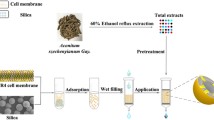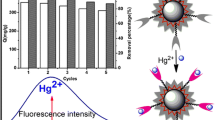Abstract
Magnetic solid phase extraction with the functionalization of protein onto micro- or nano-particles as a probe is favorable for the discovery of new drugs from complicated natural products. Herein, we aimed to develop a rapid method by immobilizing halogenated alkane dehalogenase (Halo)-tagged calcium-sensing receptor (CaSR) directly out of crude cell lysates onto the surface of magnetic microspheres (MM) with no need to purify protein. Thereby we achieved CaSR-functionalized MM for revealing adsorption characteristics of agonist neomycin and screening ligands from herbal medicine Radix Astragali (RA). About 43.87 mg CaSR could be immobilized per 1 g MM within 30 min, and the acquired CaSR-functionalized MM showed good stability and activity for 4 weeks. The maximum adsorption capacity of neomycin on CaSR-functionalized MM was determined as 4.70 × 10−4 ~ 3.96 × 10−4 mol/g within 277 ~ 310 K, and its adsorption isotherm characteristics described best by the Temkin model were further validated using isothermal titration calorimetry. It was inferred that CaSR’s affinity for neomycin was driven by electrostatic forces in a spontaneous process when the system reached an equilibrium state. Moreover, the ligands from the RA extract were screened, three of which were assigned as astragaloside IV, ononin, and calycosin based on HPLC–MS. Our findings demonstrated that the functionalization of a receptor onto magnetic materials designed as an affinity probe has the capability to recognize its agonist and capture the ligands selectively from complex matrices like herbs.
Graphical abstract







Similar content being viewed by others
Data Availability
The datasets generated during and/or analysed during the current study are preferred for Microchimica Acta.
References
Lu AH, Salabas EL, Schuth F (2007) Magnetic nanoparticles: synthesis, protection, functionalization, and application. Angew Chem Int Edit 46:1222–1244
Huang XL, Zhuang J, Chen D, Liu HY, Tang FQ, Yan XY, Meng XW, Zhang L, Ren J (2009) General strategy for designing functionalized magnetic microspheres for different bioapplications. Langmuir 25:11657–11663
Ito A, Shinkai M, Honda H, Kobayashi T (2005) Medical application of functionalized magnetic nanoparticles. J Biosci Bioeng 100:1–11
Xu JK, Sun JJ, Wang YJ, Sheng J, Wang F, Sun M (2014) Application of iron magnetic nanoparticles in protein immobilization. Molecules 19:11465–11486
Motejadded H, Kranz B, Berensmeier S, Franzreb M, Altenbuchner J (2010) Expression, one-step purification, and immobilization of HaloTag (TM) fusion proteins on chloroalkane-functionalized magnetic beads. Appl Biochem Biotechnol 162:2098–2110
Kosobokova EN, Skrypnik KA, Kosorukov VS (2016) Overview of fusion tags for recombinant proteins. Biochem Mosc 81:187–200
Zanker AA, Ahmad N, Son TH, Schwaminger SP, Berensmeier S (2021) Selective ene-reductase immobilization to magnetic nanoparticles through a novel affinity tag. Biotechnol J 16:2000366
Los GV, Encell LP, McDougall MG, Hartzell DD, Karassina N, Zimprich C, Wood MG, Learish R, Ohane RF, Urh M, Simpson D, Mendez J, Zimmerman K, Otto P, Vidugiris G, Zhu J, Darzins A, Klaubert DH, Bulleit RF, Wood KV (2008) HatoTag: a novel protein labeling technology for cell imaging and protein analysis. ACS Chem Biol 3:373–382
England CG, Luo HM, Cai WB (2015) HaloTag technology: a versatile platform for biomedical applications. Bioconjug Chem 26:975–986
Chen WY, Younis MH, Zhao ZK, Cai WB (2022) Recent biomedical advances enabled by HaloTag technology. Biocell 46:1789–1801
Thakker RV (2004) Diseases associated with the extracellular calcium-sensing receptor. Cell Calcium 35:275–282
Madhavan P, Van Do TH, Bale A, Majumdar S (2019) A novel mutation in calcium-sensing receptor presenting as familial hypocalciurichypercalcemia in a young man. AACE Clin Case Rep 5:e226–e229
Zhang WH, Xu CQ (2009) Calcium sensing receptor and heart diseases. Pathophysiology 16:317–323
Paquot F, Huart J, Defraigne JO, Krzesinski JM, Jouret F (2015) Implications of the calcium-sensing receptor in ischemia/reperfusion. Acta Cardiol 72:125–131
Ward BK, Magno AL, Walsh JP, Ratajczak T (2012) The role of the calcium-sensing receptor in human disease. Clin Biochem 45:943–953
Hannan FM, Kallay E, Chang WH, Brandi ML, Thakker RV (2018) The calcium-sensing receptor in physiology and in calcitropic and noncalcitropic diseases. Nat Rev Endocrinol 15:33–51
Deng XN, Xin Y, Miller CL, Hamelberg D, Kirberger M, Moremen KW, Hu J, Yang JJ (2020) Structural mechanism of cooperative regulation of calcium-sensing receptor-mediated cellular signaling. Curr Opin Physiol 17:269–277
Hu JX, Spiegel AM (2007) Structure and function of the human calcium-sensing receptor: insights from natural and engineered mutations and allosteric modulators. J Cell Mol Med 11:908–922
Xu R, Cheng PX, Meng KL, Li LK, Jiao MZ, Zhao X, Jia P, Zheng XH, Xiao CN (2022) Extracellular domain of human calcium sensing receptor immobilized to silica beads as biomaterial: A rapid chromatographic method for recognizing ligands from complex matrix “Shuangdan.” J Chromatogr, B: Anal Technol Biomed Life Sci 1208:123409
Meng KL, Jiao MZ, Shi XG, Xu R, Cheng PX, Lv HT, Zheng XH, Xiao CN (2023) A rapid approach to capture the potential bioactive compounds from Rhizoma Drynariae, utilizing disease-associated mutation in calcium sensing receptor to alter the binding affinity for agonists. J Pharm Biomed Anal 226:10
Su HF, Shaker S, Kuang Y, Zhang M, Ye M, Qiao X (2021) Phytochemistry and cardiovascular protective effects of Huang-Qi (Astragali Radix). Med Res Rev 41:1999–2038
Liang CR, Yao YQ, Ding HR, Li XM, Li YB,Cai T (2022) Rapid classification and identification of chemical components of Astragali Radix by UPLC-Q-TOF-MS. Phytochem Anal 1–18
Zhang CH, Yang X, Wei JR, Chen NMH, Xu JP, Bi YQ, Yang M, Gong X, Li ZY, Ren K, Han QH, Zhang L, Li X, Ji MY, Wang CC, Li MH (2021) Ethnopharmacology, phytochemistry, pharmacology, toxicology and clinical applications of Radix Astragali. Chin J Integr Med 27:229–240
Gerbino A, Colella M (2018) The different facets of extracellular calcium sensors: old and new concepts in calcium-sensing receptor signalling and pharmacology. Int J Mol Sci 19:999
Sun JH, Murphy E (2010) Calcium-sensing receptor: a sensor and mediator of ischemic preconditioning in the heart. Am J Physiol Heart Circ Physiol 299:H1309–H1317
Langmuir I (1916) The constitution and fundamental properties of solids and liquids. Part I. Solids. J Am Chem Soc 38:2221–2295
Tan IAW, Ahmad AL, Hameed BH (2009) Adsorption isotherms, kinetics, thermodynamics and desorption studies of 2,4,6-trichlorophenol on oil palm empty fruit bunch-based activated carbon. J Hazard Mater 164:473–482
Vasiliu S, Bunia I, Racovita S, Neagu V (2011) Adsorption of cefotaxime sodium salt on polymer coated ion exchange resin microparticles: kinetics, equilibrium and thermodynamic studies. Carbohyd Polym 85:376–387
Freundlich H (1926) Adsorption in solution. Phys Chem 57:384–410
Temkin MI, Pyzhev V (1940) Kinetics of ammonia synthesis on promoted iron catalyst. Acta Physiochim 12:327–356
Pursell CJ, Hartshorn H, Ward T, Chandler BD, Boccuzzi F (2011) Application of the Temkin model to the adsorption of CO on gold. J Phys Chem C 115:23880–23892
Goldsmith PK, Fan GF, Ray K, Shiloach J, McPhie P, Rogers KV, Spiegel AM (1999) Expression, purification, and biochemical characterization of the amino-terminal extracellular domain of the human calcium receptor. J Biol Chem 274:11303–11309
Ryan ZC, Craig TA, Venyaminov SY, Thompson JR, Kumar R (2006) Biophysical properties of the extra-cellular domain of the calcium-sensing receptor. Biochem Biophys Res Commun 349:339–344
Brown EM, Butters R, Katz C, Kifor O (1991) Neomycin mimics the effects of high extracellular calcium concentrations on parathyroid function in dispersed bovine parathyroid cells. Endocrinology 128:3047–3054
McLarnon SJ, Holden D, Ward DT, Jones MN, Elliott AC, Riccardi D (2002) Aminoglycoside antibiotics induce pH-sensitive activation of the calcium-sensing receptor. Biochem Biophys Res Commun 297:71–77
Katz CL, Butters RR, Chen CJ, Brown EM (1992) Structure-function relationships for the effects of various aminoglycoside antibiotics on dispersed bovine parathyroid cells. Endocrinology 131:903–910
Chu C, Qi LW, Liu EH, Li B, Gao W, Li P (2010) Radix Astragali latest advancements and trends in chemistry, analysis, pharmacology and pharmacokinetics. Curr Org Chem 14:1792–1807
Park JJ, Lee WY (2021) Adsorption and desorption characteristics of a phenolic compound from Ecklonia cava on macroporous. Food Chem 338:128150
Ross PD, Subramanian S (1981) Thermodynamics of protein association reactions: forces contributing to stability. Biochemistry 20:3096–3102
Josepovitz C, Pastoriza-Munoz E, Timmerman D, Scott M, Feldman S, Kaloyanides GJ (1982) Inhibition of gentamicin uptake in rat renal cortex in vivo by aminoglycosides and organic polycations. J Pharmacol Exp Ther 223:314–321
Ward WH, Holdgate GA (2001) Isothermal titration calorimetry in drug discovery. Prog Med Chem 38:309–376
Krimmer SG, Klebe G (2015) Thermodynamics of protein-ligand interactions as a reference for computational analysis: how to assess accuracy, reliability and relevance of experimental data. J Comput-Aided Mol Des 29:867–883
Fei FH, Sun HM, Cheng XX, Liu JJ, Wang J, Li Q, Zhang YJ (2018) Rapid screening and identification of bioactive compounds specifically binding to beta 2-adrenoceptor from San-ao decoction using affinity magnetic fine particles coupled with high-performance liquid chromatography-mass spectrometry. Chin Med 13:49
Liu XH, Zhao LG, Liang J, Guo L, Yang YL, Hu F, Zhu RJ, Feng SL (2014) Component analysis and structure identification of active substances for anti-gastric ulcer effects in Radix Astragali by liquid chromatography and tandem mass spectrometry. J Chromatogr B-Anal Technol Biomed Life Sci 960:43–51
Yang L, Li RR, Qin XM,Li ZY (2022) Chemical comparison of Astragali Radix by UHPLC/Q-TOF-MS with different growing patterns. Eur Food Res Technol
Geng Y, Mosyak L, Kurinov I, Zuo H, Sturchler E, Cheng TC, Subramanyam P, Brown AP, Brennan SC, Mun H-c, Bush M, Chen Y, Nguyen TX, Cao B, Chang DD, Quick M, Conigrave AD, Colecraft HM, McDonald P, Fan QR (2016) Structural mechanism of ligand activation in human calcium-sensing receptor. Elife 5:e13662
Diao JY, DeBono A, Josephs TM, Bourke JE, Capuano B, Gregory KJ, Leach K (2021) Therapeutic opportunities of targeting allosteric binding sites on the calcium-sensing receptor. ACS Pharmacol Transl Sci 4:666–679
Du SJ, Zhang Y, Zhao YM, Dong YJ, Tang JL, Zhou XH, Gao WJ (2021) Astragaloside IV attenuates cerebral ischemia-reperfusion injury in rats through the inhibition of calcium-sensing receptor-mediated apoptosis. Int J Mol Med 47:302–314
Yin B, Hou XW, Lu ML (2019) Astragaloside IV attenuates myocardial ischemia/reperfusion injury in rats via inhibition of calcium-sensing receptor-mediated apoptotic signaling pathways. Acta Pharmacol Sin 40:599–607
Lu ML, Lang B, He X, Zhang Z, Wang HX, Tang FT (2018) Calcium sensing receptor-related pathway contributes to cardiac Injury and the mechanism of Astragaloside IV on cardioprotection. Front Pharmacol 9:1163
Acknowledgements
This work was supported by the Shaanxi QinChuangYuan “Scientist and Engineer” Team (2022KXJ-110) and the Shaanxi Key Research and Development Project (2018KWZ-05).
Author information
Authors and Affiliations
Contributions
Peixuan Cheng: investigation and writing-original draft. Kaili Meng: investigation. Meizhi Jiao: data curation. Xiangang Shi: data curation. Yaokun Han: methodology. Xia Li: project administration. Pei Liu: validation. Chaoni Xiao: resources, supervision, and writing, review, and editing.
Corresponding author
Ethics declarations
Conflict of interest
The authors declare no conflict of interest.
Additional information
Publisher's Note
Springer Nature remains neutral with regard to jurisdictional claims in published maps and institutional affiliations.
Supplementary Information
Below is the link to the electronic supplementary material.
Rights and permissions
Springer Nature or its licensor (e.g. a society or other partner) holds exclusive rights to this article under a publishing agreement with the author(s) or other rightsholder(s); author self-archiving of the accepted manuscript version of this article is solely governed by the terms of such publishing agreement and applicable law.
About this article
Cite this article
Cheng, P., Meng, K., Shi, X. et al. Solid-phase extraction with the functionalization of calcium-sensing receptors onto magnetic microspheres as an affinity probe can capture ligands selectively from herbal extract. Microchim Acta 191, 34 (2024). https://doi.org/10.1007/s00604-023-06092-4
Received:
Accepted:
Published:
DOI: https://doi.org/10.1007/s00604-023-06092-4




